Accounts Receivables vs. Accounts Payables: What’s the Difference?
Plooto
FEBRUARY 15, 2024
What is accounts receivable and accounts payable? Find out why having good control over both is crucial for your business to have a smooth cash flow.
This site uses cookies to improve your experience. By viewing our content, you are accepting the use of cookies. To help us insure we adhere to various privacy regulations, please select your country/region of residence. If you do not select a country we will assume you are from the United States. View our privacy policy and terms of use.
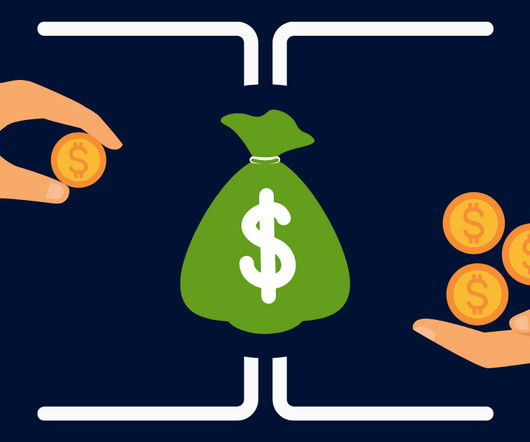
Plooto
FEBRUARY 15, 2024
What is accounts receivable and accounts payable? Find out why having good control over both is crucial for your business to have a smooth cash flow.
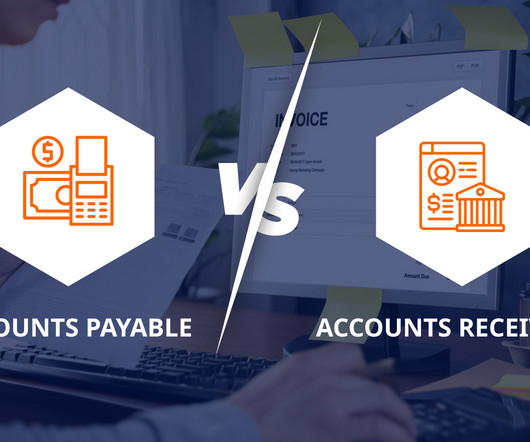
Invoicera
APRIL 2, 2024
The accounts receivables and payables management records have a unique significance in the business world. Let’s dive into detailed information about Accounts Payable and Receivable Management and their importance. What is Accounts Payable Management? Paying your bills on time is important!
This site is protected by reCAPTCHA and the Google Privacy Policy and Terms of Service apply.
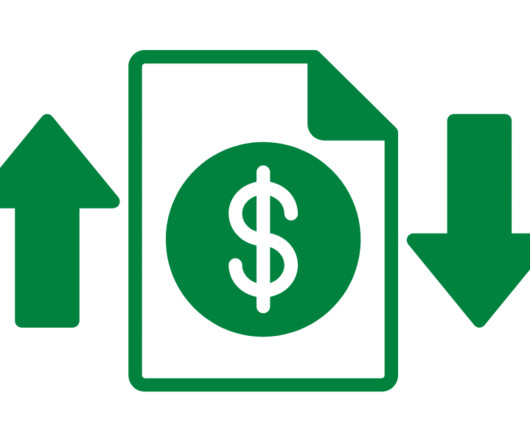
Counto
FEBRUARY 3, 2024
Accounts Payable vs. Accounts Receivable: What’s The Difference? In the world of business finance, managing your accounts payable (AP) and accounts receivable (AR) is vital for maintaining a healthy financial outlook. net-30 or net-90), the outstanding payment remains in accounts payable.

Accounting Tools
JUNE 17, 2023
Related Courses Bookkeeping Guidebook Effective Collections How to Audit Receivables What is Accounts Receivable? Accounts receivable refers to money due to a seller from buyers who have not yet paid for their purchases. The amount of non trade receivables is usually quite small.

AvidXchange
OCTOBER 15, 2023
How Does Accounts Receivable Work? Accounts receivable (AR) refers to the outstanding invoices a company has or the money it is owed from its clients. Table of Contents What is Accounts Receivable? Accounts receivable should not be confused with accounts payable (AP).

Accounting Tools
SEPTEMBER 7, 2023
Related Courses Bookkeeping Guidebook How to Audit Receivables New Controller Guidebook Accounts receivable is the amount owed to a seller by a customer. Accounts receivable is listed as a current asset on the balance sheet , since it is usually convertible into cash in less than one year.

CSI Accounting & Payroll
NOVEMBER 16, 2023
At CSI Accounting & Payroll, we’ve worked with small business finances for over 50 years. Thousands of small businesses have outsourced their financial needs to us, but we don’t handle their accounts payable (bill pay) or accounts receivable (collections). Why is that?

Gaviti
MARCH 3, 2024
Many of these organizations focus on implementing RPA in the financial and accounts receivable department, where employees are burdened with repetitive manual tasks. What is Robotic Process Automation (RPA) in Accounts Receivable? Benefits of accounts receivable automation include: It’s more efficient.

Nanonets
SEPTEMBER 22, 2023
Accounts receivable is a crucial aspect of financial management for businesses, and understanding how to effectively manage it is essential for maintaining a healthy cash flow and business growth. Efficient management of accounts receivable is essential for maintaining a healthy cash flow and avoiding liquidity problems.

Accounting Tools
JUNE 20, 2023
Related Courses Business Ratios Guidebook Credit and Collection Guidebook The Interpretation of Financial Statements What is Accounts Receivable Analysis? Accounts receivable are the amounts owed to a business by its customers , and are comprised of a potentially large number of invoiced amounts.

Nanonets
MAY 8, 2023
Try Nanonets accounting automation software to streamline all your accounting receivable processes. Start your free trial Accounts receivable (AR) is an asset on a company's balance sheet. In other words, accounts receivable is the money a company expects to receive in the future from its customers.

AvidXchange
JUNE 6, 2022
Accounts receivable (AR) refers to the outstanding invoices a company has or the money it is owed from its clients. In your personal life, an example of Accounts Receivable would be buying a ticket to a concert or sporting event for a friend with the understanding that they will pay you back later.

Gaviti
MAY 30, 2023
Accounts receivable is one of the most critical roles in your business. Receivables management can also become incredibly complex and high-risk. This risk compels savvy business managers to consider whether they should use accounts receivable outsourcing or turn to management software.

AvidXchange
JUNE 6, 2022
Accounts receivable (AR) refers to the outstanding invoices a company has or the money it is owed from its clients. In your personal life, an example of Accounts Receivable would be buying a ticket to a concert or sporting event for a friend with the understanding that they will pay you back later.

Outsourced Bookeeping
FEBRUARY 8, 2023
Accounts receivable and business collections are essential components of any business. As the year 2023 approaches, new accounts receivable trends and collection strategies will become increasingly important to ensure a healthy cash flow and financial stability.

Outsourced Bookeeping
FEBRUARY 8, 2023
Accounts receivable and business collections are essential components of any business. As the year 2023 approaches, new accounts receivable trends and collection strategies will become increasingly important to ensure a healthy cash flow and financial stability.

Outsourced Bookeeping
APRIL 12, 2023
It is a process that initiates with an order received from a customer and ends with the successful collection of payment from them. Accounts receivable management and payment collection from customers are crucial steps in this cycle. If this is too much of a hassle, one can also opt for accounts receivable services.

Jetpack Workflow
MARCH 23, 2023
In most cases, you’ll find yourself delivering the product or service first, along with an invoice, and receiving payment later. This process is why an accounts receivable (AR) ledger is your best friend. You may have made a sale, but the transaction isn’t complete until the money is in your bank account.

Nanonets
SEPTEMBER 22, 2023
The accounts receivable cycle plays a crucial role in the financial health of businesses, enabling them to streamline operations, optimize cash flow, and ultimately get paid faster. Accounts receivable refers to the amount of money owed to a company for goods or services already provided on credit.

Nanonets
SEPTEMBER 22, 2023
Accounts payable and accounts receivable play a crucial role in a company's financial health and should be managed effectively for optimal cash flow and accurate balance sheet reporting. What is Accounts Payable?

Invoicera
APRIL 28, 2024
Too many unpaid bills or Accounts Payable can weigh a company down and eat its profits. And on average, 48% of businesses make 68% fewer profits because of issues with unattended accounts payable. Let’s begin by understanding a little about accounts payable. What Are Accounts Payable?

Fidesic blog
JANUARY 19, 2023
A Microsoft Dynamics GP customer recently came to Fidesic because they were facing an increasingly common problem--they were struggling to hire an accounts payable clerk. The fact is that the industry is currently in a talent shortage as ‘accounting clerk’ has been a difficult position to fill in recent years.

AvidXchange
JANUARY 29, 2021
Streamlined accounts receivable processes and well-managed cash flow can help sustain business operations. Move to electronic invoicing Streamlining accounts receivables all starts with the invoice. Managing cash flow is top of mind for business owners who serve as vendors to companies throughout different industries.

Accounting Tools
SEPTEMBER 19, 2023
Related Courses How to Audit Liabilities Optimal Accounting for Payables Payables Management What is Accounts Payable? Accounts payable is the aggregate amount of one's short-term obligations to pay suppliers for products and services that were purchased on credit.

Counto
FEBRUARY 4, 2024
Accounts Payable Process: Overcoming Common Challenges with Automation Managing your accounts payable (AP) process effectively is crucial for maintaining smooth financial operations and vendor relationships. Slow Processing: Manual paper-based processes slow down your accounts payable workflow considerably.

Nanonets
MARCH 21, 2023
Accounts payable defined The accounts payable is an accounting term that refers to the money that a company owes to a vendor or a supplier – for having availed of their products or services. The account payable is recorded when an invoice is approved for payment. No code required.

MineralTree
AUGUST 10, 2023
But a key component of cash flow balance — accounts payable — is often overlooked. Accounts payable (AP) is inherently tied to a business’ financial stability. Let’s review the role of accounts payable on cash flow and dive into best practices for optimizing cash flow.
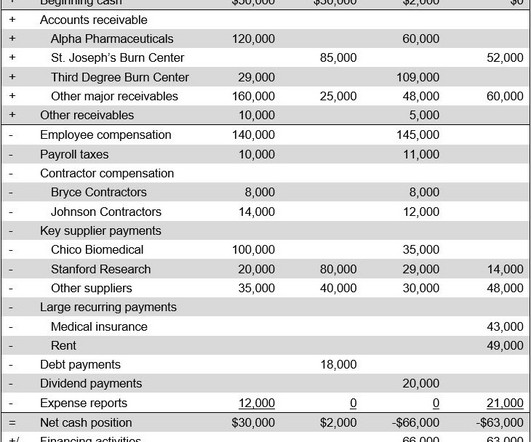
Accounting Tools
MAY 13, 2024
It is derived from actual and estimated accounts receivable and accounts payable. Outside of the period covered by accounts receivable and accounts payable, a business needs to use alternative cash forecasting methods that tend to be less accurate.

Nanonets
JANUARY 25, 2024
Automating accounts payable (AP) differs from many other enterprise business processes. For that reason, relevant communities and resources for accounts payable extend beyond finance. For that reason, relevant communities and resources for accounts payable extend beyond finance.

Accounting Tools
MAY 13, 2024
In most cases, a high asset turnover ratio is considered good, since it implies that receivables are collected quickly, fixed assets are heavily utilized, and little excess inventory is kept on hand. This implies a minimal need for invested funds, and therefore a high return on investment.

Jetpack Workflow
MARCH 30, 2023
An accounts payable ledger helps you keep your accounts payable transactions in order so nothing falls through the cracks. In this article, we’ll discuss what an accounts payable template is, the line items it should have, and alternatives to using a manual template.
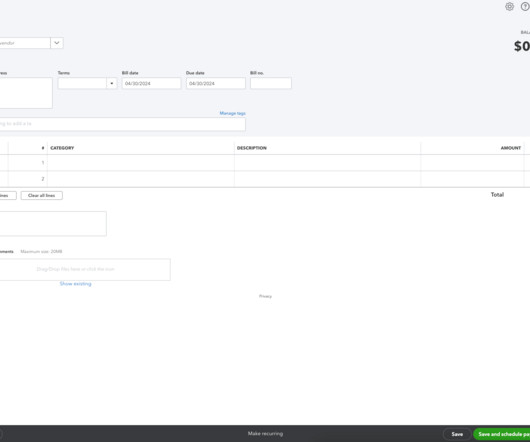
Nanonets
MAY 1, 2024
Invoicing and managing accounts payable digitally are a fact of life for business owners today, whether a small, local mom-and-pop or an eCommerce juggernaut selling thousands of dollars worth of inventory daily. QuickBooks offers a range of basic accounts receivable and payable solutions to simplify many tricky processes.
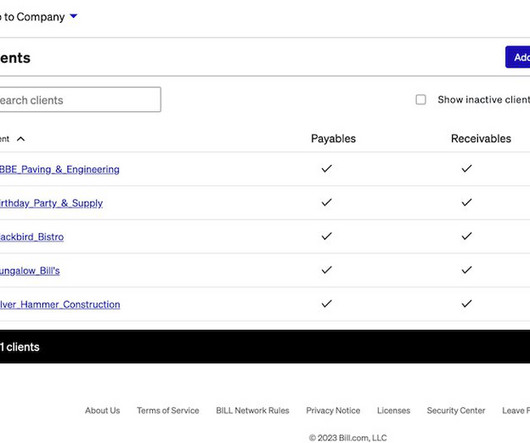
Insightful Accountant
OCTOBER 5, 2023
The new financial operations platform for SMBs integrates category-leading solutions across accounts payable (AP), accounts receivable (AR), and spend and expense management.
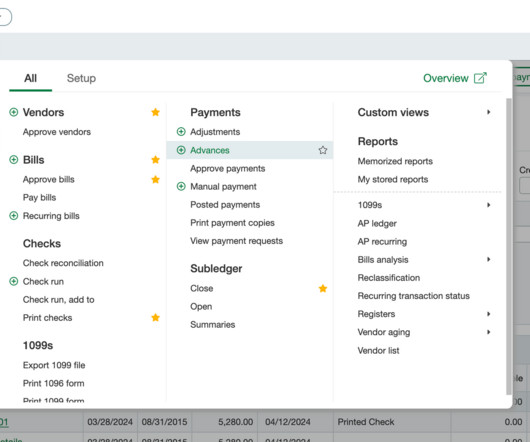
Nanonets
APRIL 12, 2024
It creates professional invoices for your accounts receivables and helps process invoices as part of your accounts payables. Invoice Creation in Sage Intacct Accounts Receivable Tab to create invoices Sage Intacct streamlines invoice creation, freeing you from tedious tasks.

Ace Cloud Hosting
FEBRUARY 12, 2024
QuickBooks is excellent accounting software designed for small-to-medium-sized businesses. It’s a comprehensive financial management suite that offers a range of functionalities, including Accounts Payable, Accounts Receivable, Purchase Orders, Inventory Management,

Outsourced Bookeeping
MAY 14, 2024
In this stage, you will set up accurate and consistent accounting processes. You also need to monitor diverse trends surrounding accounts receivables , three-way match different purchase orders and invoices, and receive reports before you input anything into accounts payable.

Cevinio
DECEMBER 14, 2023
He is also an expert in process automation, among other financial technologies, enabling him to identify opportunities for optimization. In this pursuit, KPIs and close monitoring are important allies for the success of the projects he leads.

Fidesic blog
DECEMBER 4, 2023
We couldn't narrow it down to just one so we chose to list 14 great blogs for accountants and other thought leadership sources on accounting. The accounting blog topics vary slightly for each one. The first 9 blogs are general accounting blogs and news sources.

Cevinio
JANUARY 31, 2024
He is also an expert in process automation, among other financial technologies, enabling him to identify opportunities for optimization. In this pursuit, KPIs and close monitoring are important allies for the success of the projects he leads.

Gaviti
JANUARY 2, 2024
Cash flow metrics are the standards by which CFOs measure cash flow health and accounts receivable performance. They are used in nearly every financial function, including accounts receivable, payable, cash flow reporting, and more. What is a Cash Flow Metric?

Accounting Tools
MAY 9, 2024
Examples are accounts receivable, inventory, and fixed assets. These are legally binding obligations payable to another entity or individual. Examples are accounts payable, taxes payable, and wages payable. These are items of economic benefit that are expected to yield benefits in future periods.

Nanonets
APRIL 12, 2024
Companies maintain various internal records to track their financial activities accurately and ensure compliance with accounting standards. Accounts Receivable Reconciliation : Accounts receivable records are reconciled by comparing the balances in the accounts receivable ledger with the amounts listed on customer invoices and statements.

Accounting Tools
JULY 18, 2023
When goods or services are sold on credit, debit accounts receivable and credit sales. If a sale is for cash, then the debit is to the cash account instead of the accounts receivable account. Allowance for doubtful accounts entry. Example Expense Journal Entries Accounts payable entry.

Outsourced Bookeeping
APRIL 27, 2023
Accounting automation is quickly becoming an essential part of successful financial management. By automating accounts payable and accounts receivable processes, businesses can reduce costs, decrease errors, and improve the accuracy of their financial reporting.
Expert insights. Personalized for you.
We have resent the email to
Are you sure you want to cancel your subscriptions?


Let's personalize your content